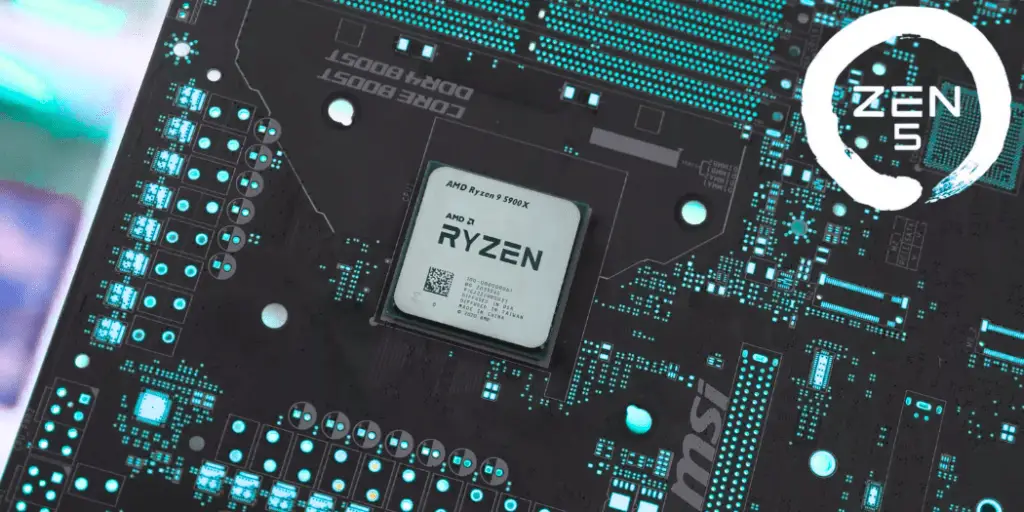AMD has recently announced its latest innovation—the Strix Point Ryzen laptop chipset to revolutionize the market with its cutting-edge performance capabilities.
Despite the recent launch of the Ryzen 8000 series, AMD is not resting on its laurels. Strix Point surpasses its predecessors and challenges the forthcoming Zen 5 architecture, indicating a significant leap in technological advancement.
AMD’s Strix Point With Gen AI and Zen 5 has announced fourth-quarter earnings in 2023, where the company reported a staggering 3,076 per cent increase in net income, this new chip underscores AMD’s aggressive push to maintain and expand its foothold in the competitive processor market.
As AMD sets the stage for a transformative year, Is the Strix Point chip emerges as a central figure in the narrative of next-generation mobile computing ?
AMD’s Strix Point With Gen AI and Zen 5
Advanced Micro Devices reported a stunning financial outcome for the fourth quarter of 2023, showcasing a monumental leap in profitability and a solid increase in revenue.
The semiconductor giant declared a net income of $667 million, a dramatic surge from the modest $21 million earned in the same quarter of the previous year.
This remarkable growth represents an increase of 3,076 per cent in net profits, highlighting the company’s successful execution of its business strategies and robust demand for its products.
The company’s revenue also grew, rising 10% to $6.168 billion. This revenue growth indicates AMD’s strong market presence and ability to capture and maintain consumer interest in its innovative product lines.
The financial figures reflect AMD’s capacity to navigate a competitive market and its adeptness in leveraging cutting-edge technology to drive sales and improve performance.
This fiscal success sets a positive tone as AMD continues to innovate and push the boundaries of processor technology with upcoming products like the Strix Point Ryzen laptop chip.
Strix Point Laptop Chip
AMD’s latest innovation in the mobile computing space, the Strix Point Ryzen laptop chip. It marks a significant milestone in the company’s product line.
Officially announced amidst AMD’s impressive financial revelations for the fourth quarter of 2023, Strix Point is set to elevate the standards of mobile CPU performance.
This chip is part of AMD’s strategic initiative to keep pace and outpace the advancements in processor technology.
Despite the recent launch of the Ryzen 8000 series, the Strix Point chip is designed to surpass these already advanced models, positioning itself ahead of the anticipated Zen 5 architecture.
It embodies AMD’s commitment to leading in AI enhancements and computational efficiency, promising substantial gains over previous iterations.
It combines the next-generation Zen 5 CPU architecture with advanced RDNA graphics, setting a new benchmark for graphic and processing power in mobile CPUs.
The chip includes an improved Ryzen AI engine, aiming to deliver more than three times the AI performance compared to the Ryzen 7040 series processors.

Energy efficiency and computational speed are significantly boosted, offering a blend of performance ideal for power users and general consumers.
Scheduled to ship in notebooks later this year, the Strix Point is eagerly anticipated by both AMD’s partners and consumers. The initial feedback from early previews and tests suggests strong customer interest and promising performance metrics.
AMD’s strategy indicates that Strix Point will not only enhance user experiences but also strengthen AMD’s market position against competitors like Intel’s Meteor Lake and Lunar Lake architectures.
Technological Advancements
AMD’s Strix Point represents a leap forward in processor technology, particularly in AI capabilities and energy efficiency. With its cutting-edge features, Strix Point is set to redefine expectations for what mobile processors can achieve.
One of the standout features of Strix Point is its enhanced AI performance. AMD has engineered this chip to deliver more than three times the AI performance compared to its predecessor, the Ryzen 7040 series.
This boost is facilitated by integrating a new and improved Ryzen AI engine, which directly enables more sophisticated machine learning and AI-based tasks on the device.
This advancement is particularly significant for applications that require real-time processing and analytics, such as voice recognition, image processing, and gaming experiences that adjust to user behaviour.
At the heart of Strix Point is AMD’s next-generation Zen 5 CPU architecture, which promises substantial improvements in both speed and efficiency. This core is designed to handle more instructions per cycle, thereby improving overall computational throughput.
Integrating Zen 5 with AMD’s advanced RDNA graphics technology also suggests that Strix Point will offer superior graphics performance, making it ideal for high-resolution video streaming, gaming, and professional graphics work.
The RDNA graphics architecture in Strix Point is expected to provide a significant uptick in graphical performance, which is crucial for a market increasingly driven by visual content and immersive experiences.
While specific details about the graphics capabilities remain under wraps, the mention of RDNA indicates a focus on delivering a balanced performance that supports both traditional computing tasks and graphically intensive applications without draining battery life excessively.
Strix Point is also engineered to be more energy-efficient, a crucial feature for mobile devices where battery life is a significant concern.
By optimizing the balance between performance and power consumption, AMD aims to address the needs of modern mobile users who require devices that can handle intense workloads without frequent recharging.
The technological advancements in Strix Point are not just incremental improvements but are indicative of AMD’s broader strategy to push the boundaries of what mobile processors can accomplish.
This includes better handling of AI and graphics-intensive applications, which are increasingly prevalent in personal and professional computing contexts.
As the chip launches into the market, it will be instrumental in driving new possibilities in mobile computing, further cementing AMD’s role as a pioneer in the semiconductor industry.
Zen 5 Architecture
AMD’s development of the Zen 5 architecture represents a critical step forward in its processor technology roadmap.
As the foundational technology for upcoming products like the Strix Point Ryzen laptop chip, Zen 5 is designed to push the limits of performance, efficiency, and AI integration, preparing AMD for future demands in a rapidly evolving market.
Zen 5 aims to increase the number of instructions per cycle, improving overall computational throughput and efficiency.
Optimizations in the architecture are designed to reduce power consumption while maintaining high performance, a key factor for mobile and desktop computing.
Zen 5 will likely incorporate features that enhance machine learning and AI processing capabilities at the chip level, natively supporting more complex AI tasks.
The development of Zen 5 is not just a technical upgrade; it reflects AMD’s strategic vision to lead in the high-performance computing segment. This architecture will enable AMD to offer products that are not only competitive but also pioneering in terms of technological advancements.

The upcoming Granite Ridge processors will be based on Zen 5, offering enhancements for high-demand desktop computing environments.
Strix Point is set to be one of the first mobile processors to leverage the Zen 5 architecture, promising significant performance and efficiency improvements in laptops.
AMD plans to integrate Zen 5 with the latest RDNA graphics technology, further boosting the graphical performance and making it suitable for gaming and professional visualization tasks.
As AMD continues to develop and roll out Zen 5-based products, the company is positioning itself to compete more aggressively with industry giants like Intel.
Market Competition
As AMD introduces the Strix Point Ryzen laptop chip, the company finds itself at a pivotal moment in the fierce competition of the processor market.
This innovative chip solidifies AMD’s commitment to advancing technology. It strategically positions itself against formidable rivals like Intel and their upcoming architectures.
Intel’s Meteor Lake and Lunar Lake are the next-generation mobile architectures that promise to deliver significant enhancements in AI performance, akin to the strides AMD is making with Strix Point.
Meteor Lake, for instance, is touted to triple the NPU AI performance, mirroring AMD’s claims of tripling AI performance with Strix Point. This sets the stage for a closely contested battle in the mobile computing sector, where both companies vie for dominance.
AMD’s approach with Strix Point—and, by extension, the Zen 5 architecture—is to offer superior AI capabilities and energy efficiency, which are increasingly critical in today’s tech-driven landscape.
AMD aims to attract traditional PC users and those engaged in more intensive computing tasks, such as content creation, gaming, and enterprise applications.

The competition does not stop at Intel. AMD must also consider other players like ARM-based chip manufacturers, who are carving out significant market share, particularly in energy efficiency and mobile devices.
AMD’s focus on integrating high-performance computing with AI capabilities is a strategic move to compete with Intel and position itself firmly against an increasingly diverse array of semiconductor companies.
Looking ahead, AMD’s success will heavily depend on its ability to consistently innovate and improve its chip technology to stay ahead of rapid technological advancements and shifting market demands. The processor market is known for its quick obsolescence of technology, requiring AMD to maintain a brisk pace in research and development.
Global supply chain issues, semiconductor manufacturing constraints, and economic factors will significantly determine how effectively AMD can execute its strategic plans.
Final Thoughts
AMD’s unveiling of the Strix Point Ryzen laptop chip marks a significant milestone in the company’s journey towards technological leadership in the processor market.
With its advanced AI capabilities, energy efficiency, and the integration of next-generation Zen 5 architecture, Strix Point is poised to redefine the landscape of mobile computing.
As AMD rolls out Strix Point, it challenges current industry benchmarks and positions itself as a formidable contender against industry giants like Intel.
The strategic emphasis on enhancing AI performance and graphical capabilities reflects AMD’s commitment to meeting the evolving demands of modern technology users—from gamers and content creators to enterprise professionals.
The competition in the processor market will undoubtedly intensify, with AMD and Intel pushing the boundaries of what is possible in mobile computing.
This competition will drive innovation, leading to more powerful, efficient, and capable computing solutions that benefit consumers and businesses.
AMD’s financial growth and robust product pipeline indicate a strong outlook for the company. As AMD continues to innovate and execute its strategic plans, it remains a crucial player to watch in the ever-evolving world of technology.


